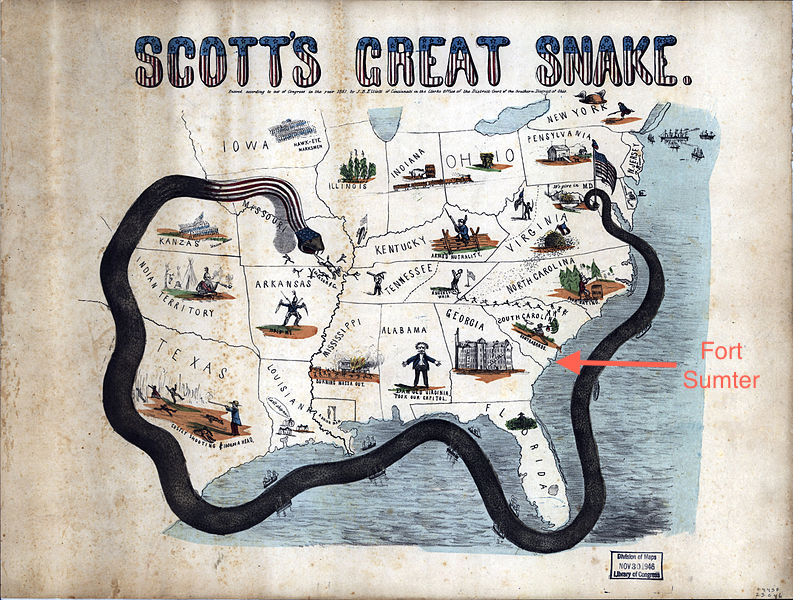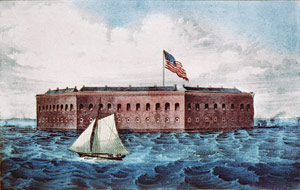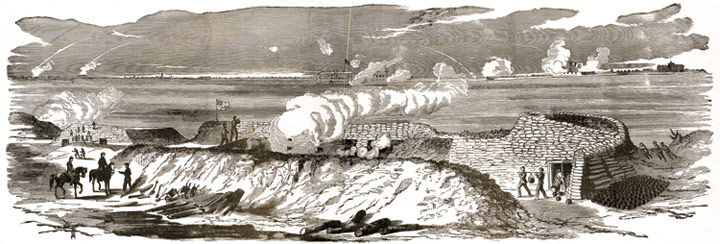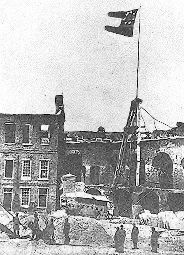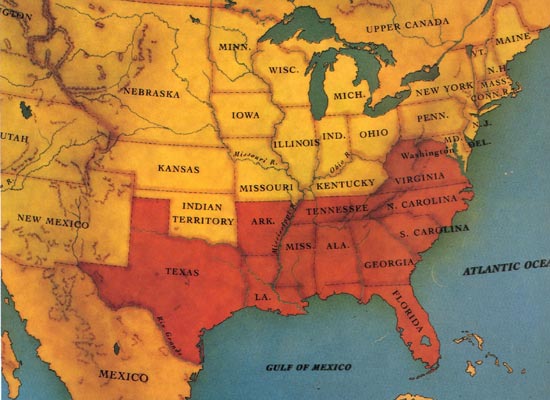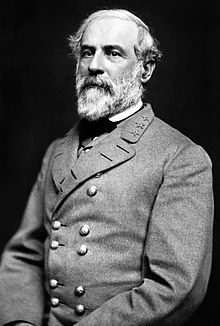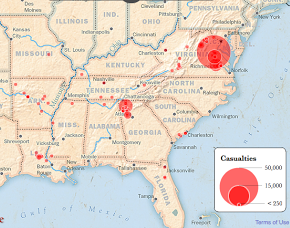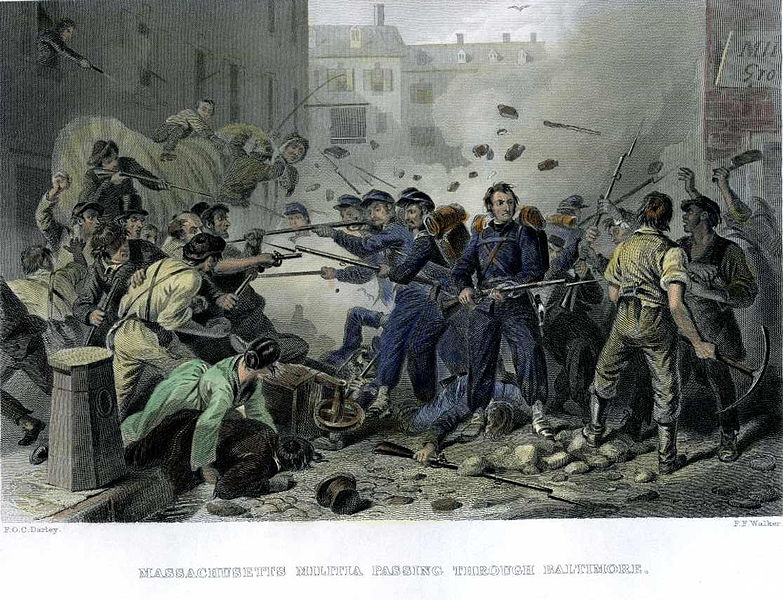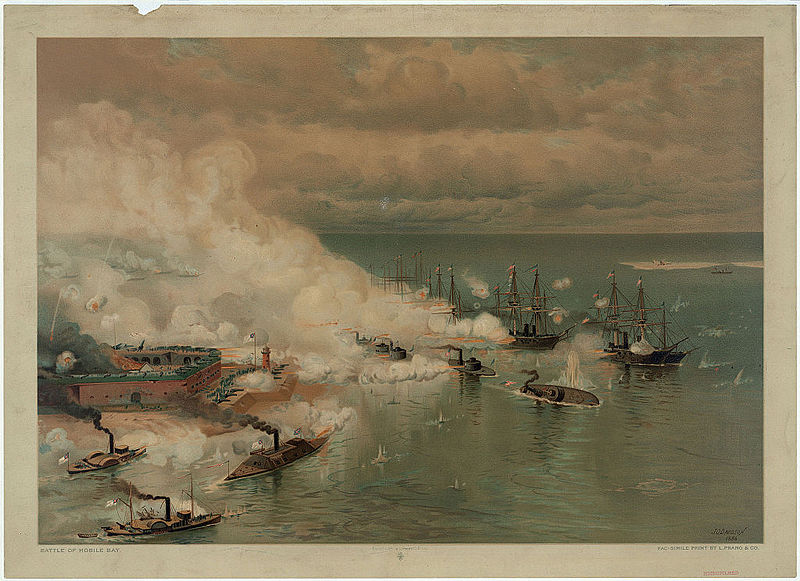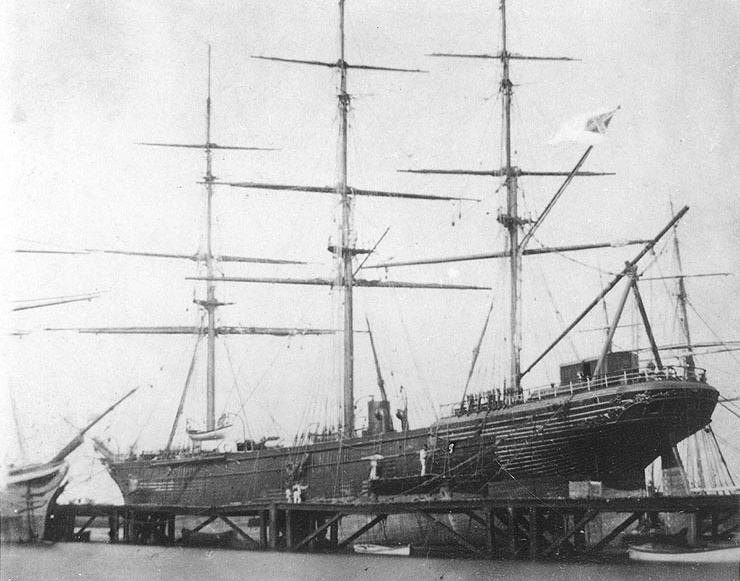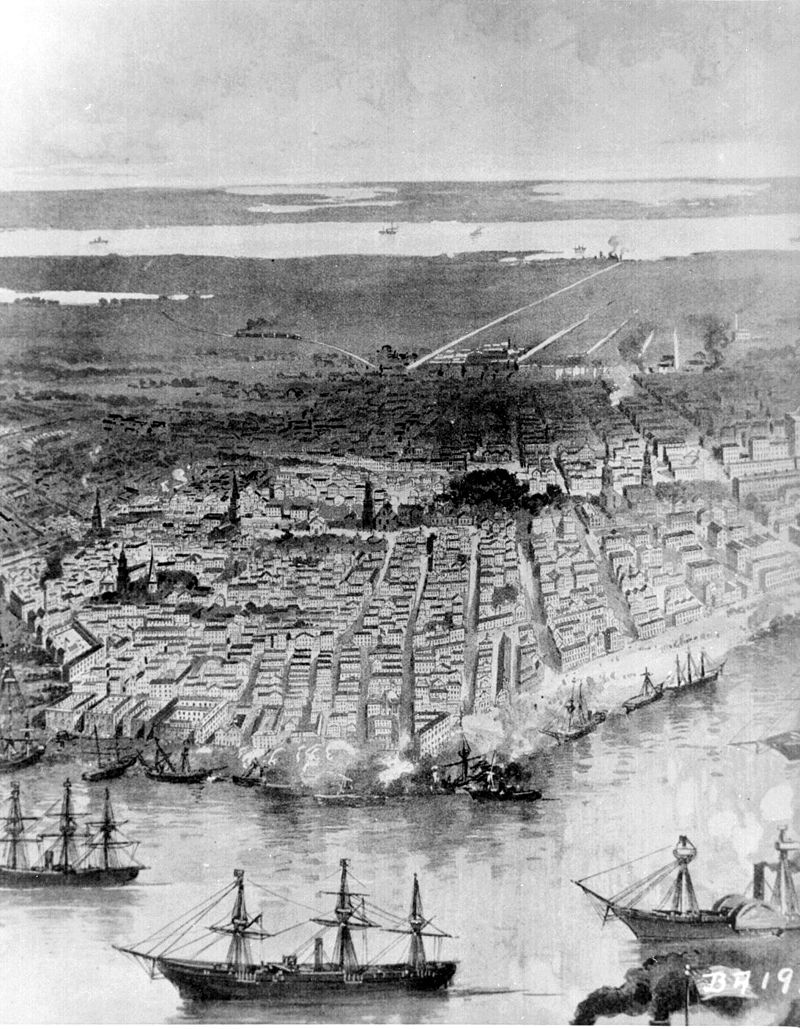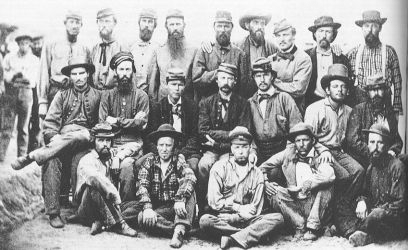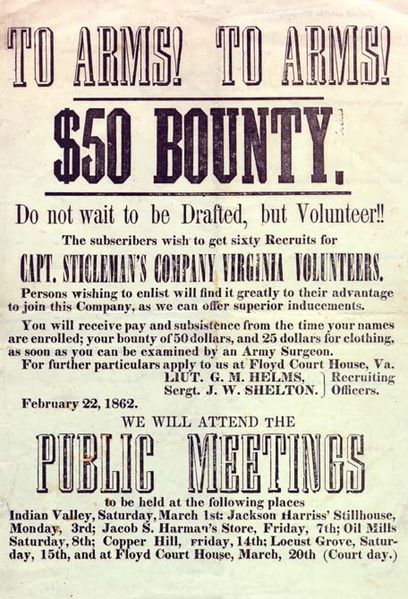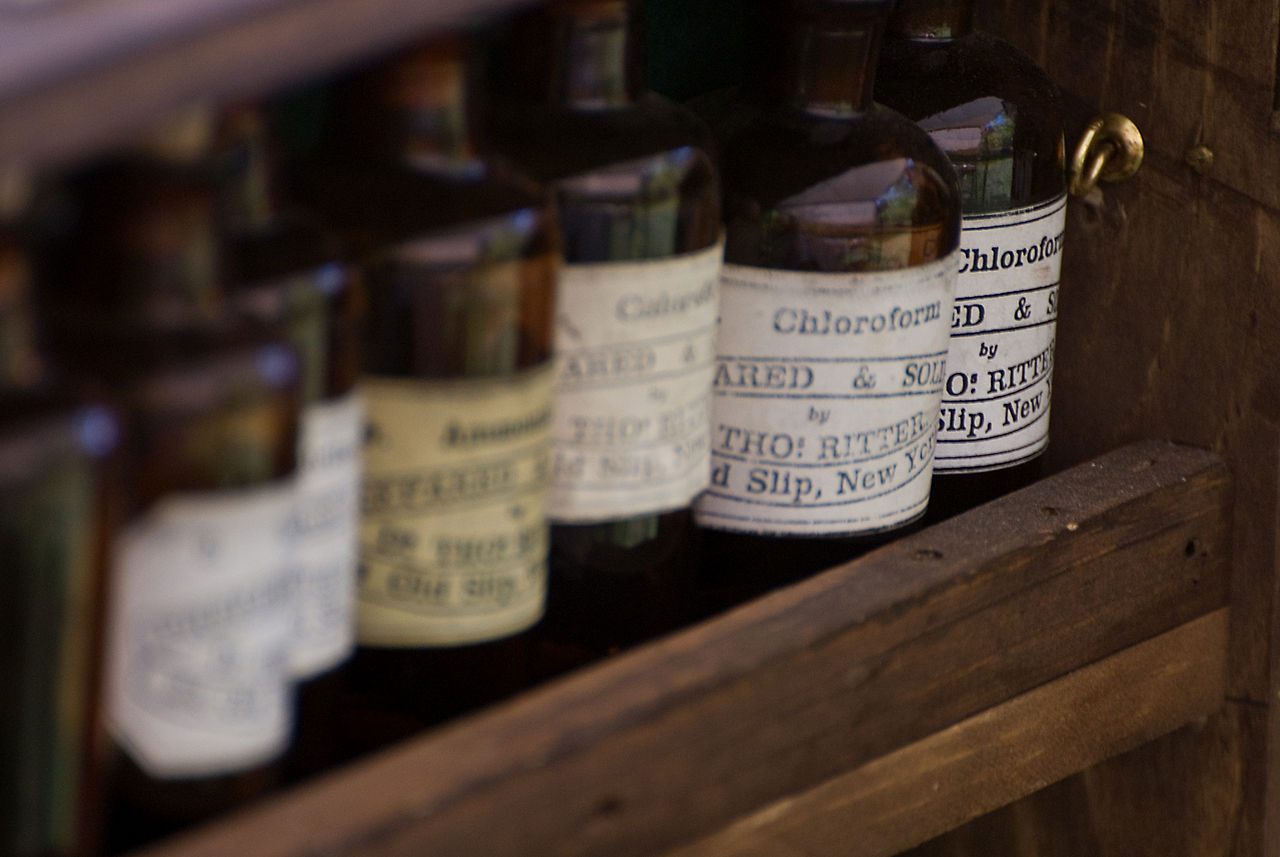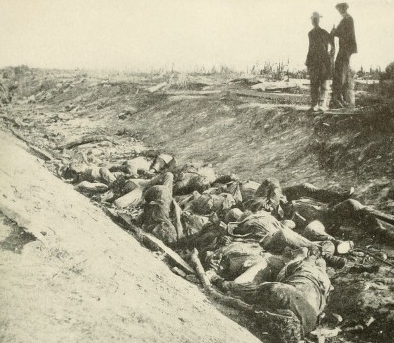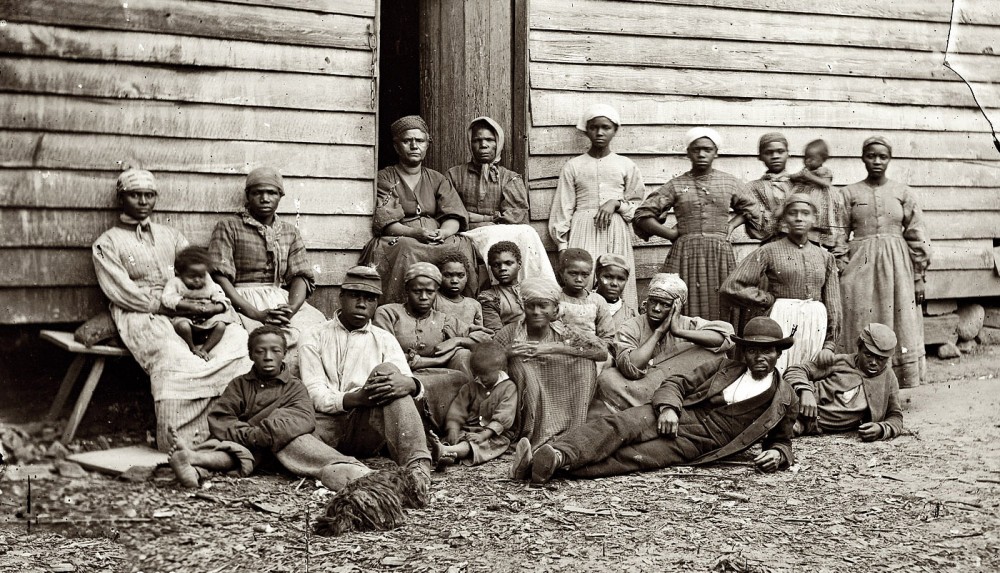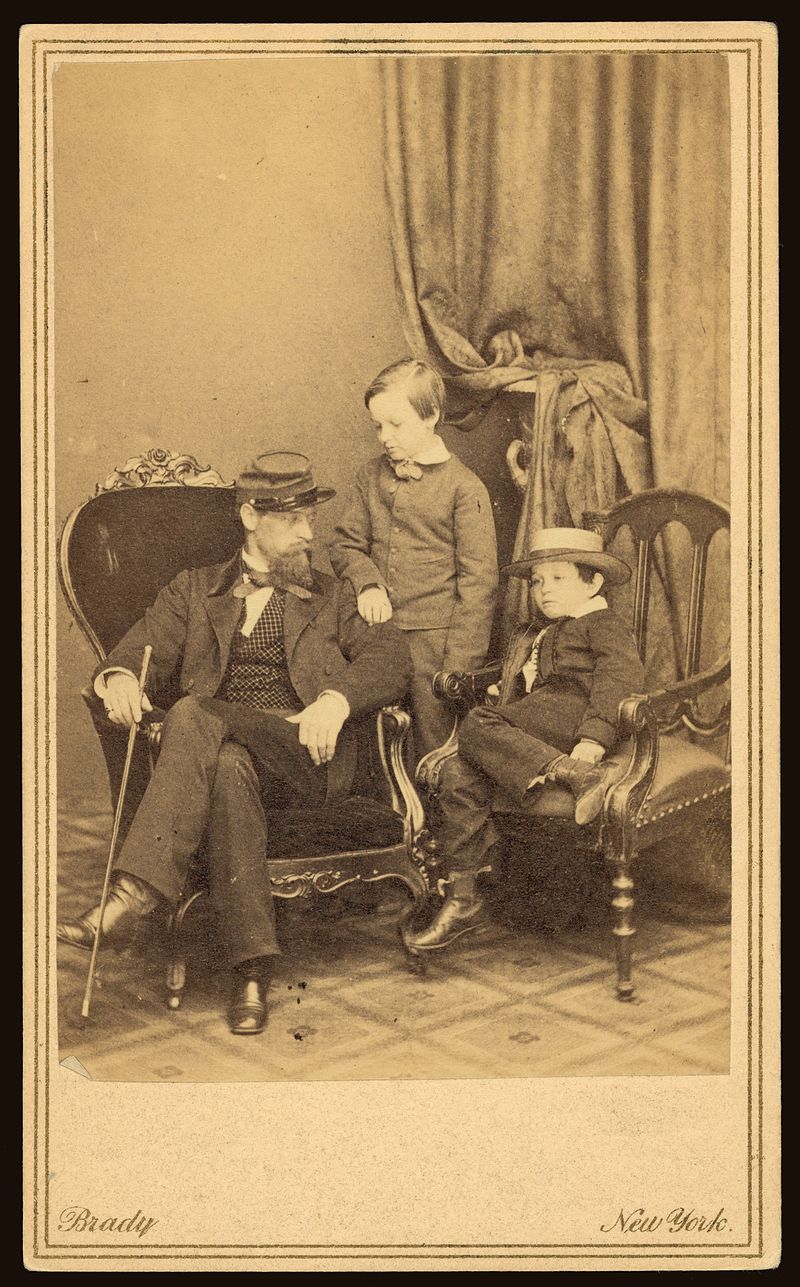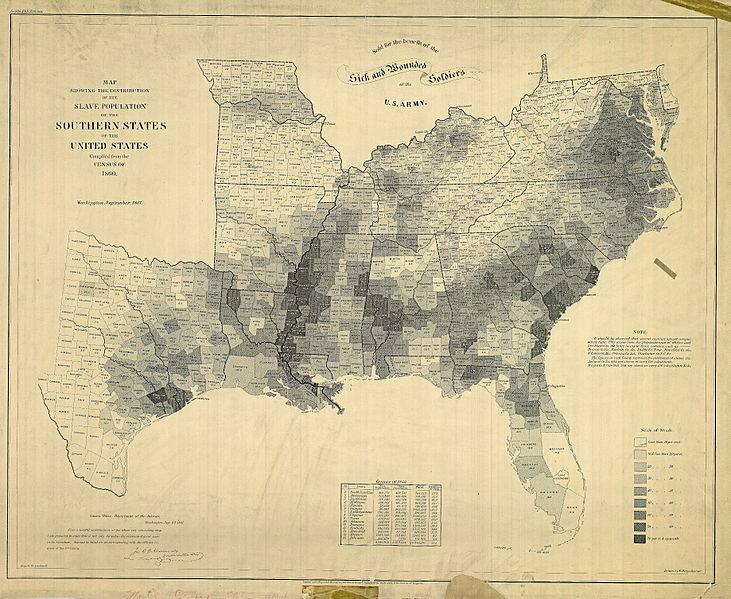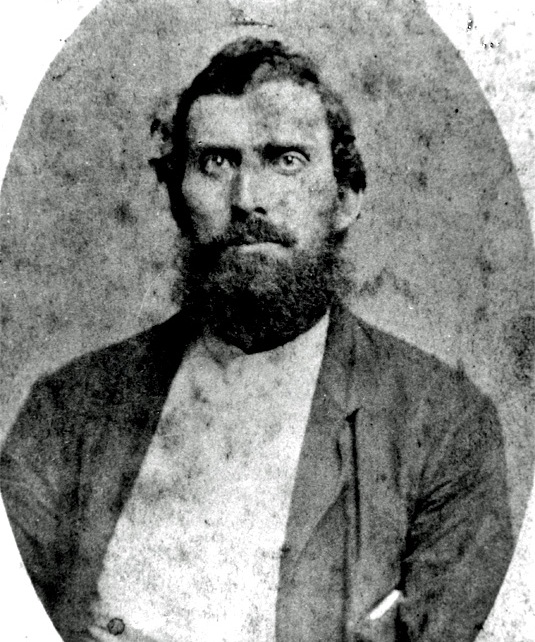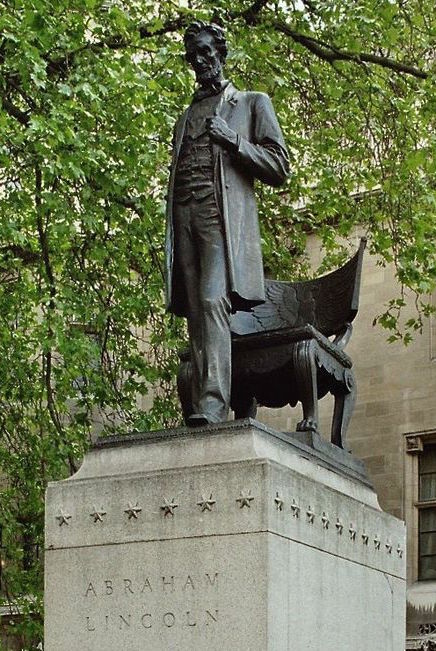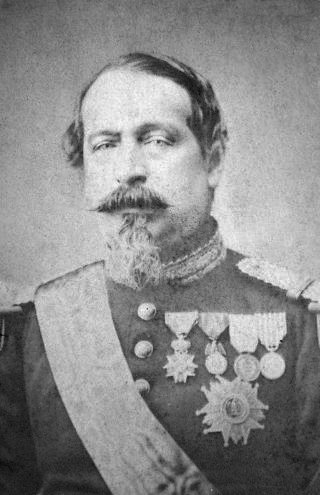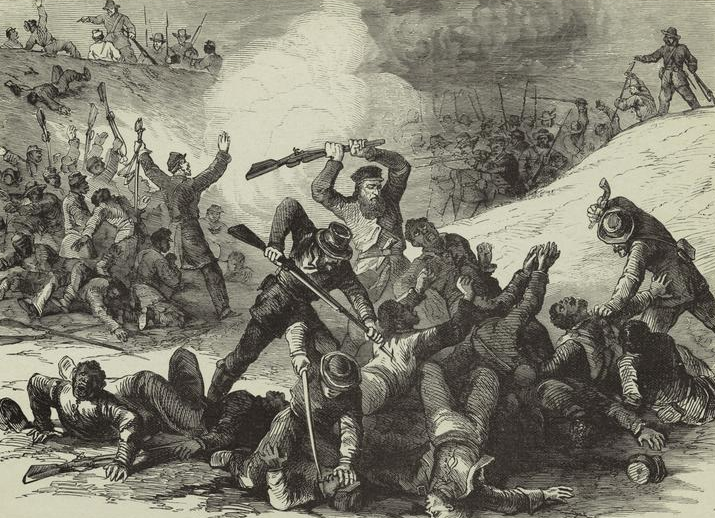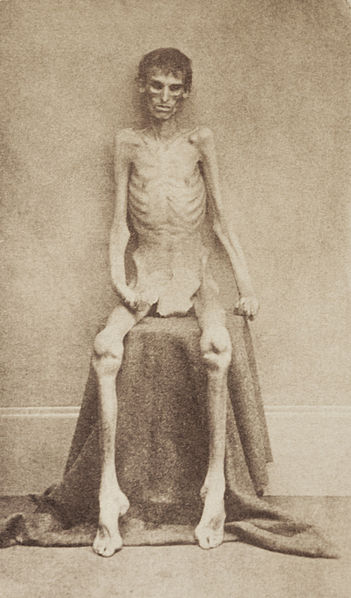“Let me tell you what is coming. After the sacrifice of countless millions of treasure and hundreds of thousands of lives, you may win Southern independence if God be not against you, but I doubt it…[Northerners] are not a fiery, impulsive people as you are, for they live in colder climates. But when they begin to move in a given direction, they move with the steady momentum and perseverance of a mighty avalanche; and what I fear is, they will overwhelm the South.” — Sam Houston, April 19th, 1861, After Losing Texas Governorship For Supporting The Union
Confederate states feared that, aside from blocking slavery’s western expansion, incoming President Abraham Lincoln might abolish it in the Southeast despite promising not to, along with raising tariffs. When they broke away to start their own nation, Lincoln used force to keep them in the United States against their will. Southern secession set off a chain of events leading to the Civil War.
Confederates occupied Fort Moultrie in Charleston, South Carolina and laid siege to Union-held Fort Sumter on an island in Charleston Harbor a mile away (red arrow on map above). This key fort was one of the installations Lincoln pointed to as having shared history and ownership, North and South, from two wars against the British. The island’s construction symbolized that union, with its brick fort built during the American Revolution on a pile of Maine granite dropped into the bay. Forts the Confederacy started taking over in January, 1861, including several in Florida and Alabama (e.g. Mt. Vernon), were all U.S. government property. The South offered compensation for the property and munitions, but Lincoln wanted to protect them for the U.S., just as the leader of most sovereign nations would. Countries don’t allow traitors or hostile armies to seize their forts as long as they pay for them.
Lincoln responded to South Carolina’s insubordination in the same way Andrew Jackson had during the Tariff Crisis of 1832, which was to threaten the state with federal force. But instead of returning fire when Confederates shot cannons from the shore, the Union just supplied the fort, forcing the Confederates’ hand. They had to either fire on the ships or suffer the humiliation of letting the Stars & Stripes fly over the fort. They chose the former and won control after a 33-hour casualty-free bombardment led by Brigadier General Pierre G.T. Beauregard. Fire Eater Edmund Ruffin purportedly fired the first shot. Lincoln saw the Confederate attack on Sumter as a traitorous act of aggression against the U.S., while the Confederacy saw the Union occupation of the fort as an invasion of their territory. Wars happen when both sides see themselves as victims defending themselves.
Fort Sumter galvanized northern support to resist secession. In that regard, it was a success for Lincoln. As he spun it in his Second Inaugural Address four years later, one side “would make war rather than let the nation survive; and the other would accept war rather than let it perish.” Sumter’s defense popularized the U.S. flag, giving the Stars-and-Stripes a role in civic life and patriotic celebrations it has enjoyed ever since. But the battle dashed the new president’s hopes for cooler heads to prevail on both sides, avoiding war altogether. The Union had to fight or acquiesce in secession. If they’d caved in and just allowed the South to keep the fort, France and Britain likely would’ve recognized the Confederacy, lending it legitimacy and strengthening its export economy. Yet Lincoln’s call for volunteers after Fort Sumter compelled four more upper Southern states to join the Confederacy: Arkansas, Tennessee, Virginia, and North Carolina, doubling the size of their army. Little Rock’s Arkansas Gazette, for instance, switched from a Unionist to secessionist stance after Sumter. If these states hadn’t been keen on leaving the U.S. initially, they were even less keen on raising arms to put down fellow Southerners. The battle for Charleston’s island fort mobilized war support in the North, dashed hopes for peace, and broadened Confederate support geographically to the Upper South.
Lincoln hoped Robert E. Lee of Virginia would lead the Union army, but Lee’s state of Virginia was one of those that seceded after Sumter. The president had pegged him because of his exemplary duty in the Mexican War, after which the head of the Mexican campaign, Winfield Scott, called the engineer the best soldier in the army. The descendent of early Virginia gentry and son of Revolutionary War officer “Light-Horse Harry” Lee III, he was superintendent of the academy at West Point, where he’d graduated at the top of his class. Robert E. Lee opposed secession, even privately ridiculing the Confederacy’s founders in letters. But Lee’s loyalties ultimately went to his “country” that, in this case, was not the U.S. or Confederacy but rather Virginia. When Virginia seceded, North Carolina was sandwiched in between South Carolina and Virginia, so they also pulled out. At this point, the Confederacy moved their capital from Montgomery, Alabama to Richmond, Virginia, further solidifying their claim as America’s rump state and dictating that military strategy would focus on a 90-mile gap separating the respective nations’ capitals, Richmond and Washington, D.C.
Strategic Backdrop
Had the Confederacy remained as only seven states, they could’ve been more easily defeated or more easily done without had they won. Conversely, had the CSA convinced Pennsylvania and New York to join, it would’ve been lopsided in the other direction. However, the CSA growing to eleven states, no less or more, made for a tragically even match geographically, lengthening the war. Lincoln imposed martial law in the four slave states remaining in the Union: Missouri, Kentucky, Maryland, and Delaware (Missouri and Kentucky tried to secede). Lincoln purportedly said that, while he hoped to have God on his side, he had to have Kentucky. But Confederates ran a shadow government in Kentucky while the Union barely hung on to Maryland. The Constitution’s mostly effective ban on the Atlantic slave trade after 1808 mattered in all this because, had there been more enslaved workers, those from the Upper South wouldn’t have been sold to cotton and sugar planters in the Deep South, which would’ve kept the institution more intact and made these four states more likely to join the Confederacy. In that line of thinking, the 1808 trade ban helped save the United States.
At the beginning of the war, there was a violent clash in Baltimore, Maryland between Union troops (Massachusetts 6th) coming through town on the railroad and pro-Confederate Marylanders. These Pratt Street Riots in April 1861 convinced Lincoln that he had to crack down hard and he threw many pro-Confederate Northerners and upper Southerners in jail with no writ of habeas corpus. He imprisoned Maryland’s secessionist state legislators without trial. Lincoln’s Habeas Corpus Suspension Act was the more extreme domestic presidential policy in American history but extreme measures were called for. Lincoln plausibly argued that without those actions the U.S. might cease to exist. Contrary to lower court challenges and a Supreme Court challenge to the Act’s military tribunals in Ex parte Milligan, Lincoln’s temporary martial law was legal. Article 1, Section 9 justifies suspending habeas corpus in the case of rebellion or invasion, and this was rebellion. The Union’s survival would’ve been threatened had Rebels taken control of Maryland since Confederate Virginia and Maryland would’ve surrounded Washington, D.C. At points in the war, the Confederacy seized control of Kentucky.
It took a while to assemble and train the Union’s Army of the Potomac, whereas Confederate militias had trained since John Brown’s Raid on Harpers Ferry in 1859. In fact, the Confederacy’s Army of Northern Virginia should’ve just invaded Washington, D.C. directly early in the war and burnt it to the ground, like the British did in 1814, before the Union Army was trained and supplied. That might have compelled the Union to give up.
The military backdrop to the Civil War was similar to the Revolutionary War insofar as the North had to invade and hold territory to subdue the South — an area approximately the size of Western Europe — in the same way the British had to with the colonies. Likewise, just as the Rebels had to hang on in the Revolution and not lose, so too, the Confederacy just had to survive until the North gave up. They seemingly had no pressing need to invade the North, nor even the need to necessarily win battle after battle in the South. I say seemingly because the CSA eventually decided that their best option was to take the offensive and invade the North and were maybe right, though both attempts failed. But, for most of the war, the Confederacy fought amidst a cooperative civilian population and knew their terrain better than Union soldiers (aka Blues or Federals). Confederate forces (aka Grays, Johnny Rebs, or Secessionists) lived off the land and civilian support, making them nimbler and more mobile than the unwieldy Union Army, that prior to 1864 moved slowly and surely, careful not to break its supply lines to the North. Superior size, equipment, and numbers can be a double-edged sword. Being over-supplied can be so disadvantageous that weaker “underdogs” have won ~ 30% of wars in recent centuries.
Also similar to British tactics in the Revolutionary War, the Union seized and held key ports, led by Navy Admiral David “Damn the Torpedoes” Farragut. In this case, holding New Orleans, Mobile, Savannah, and Charleston would, in theory, choke off cotton exports to Britain and France. The Union controlled New Orleans by 1862 and the latter three by 1864-65. New Orleans’ population was divided, partly because many disapproved of the Confederacy disbanding its militia of free black soldiers from the French Quarter, the 1st Louisiana Native Guards (CSA), 10% of whom ended up fighting for the Union. New Orleans was a key hub, but the Union still failed to block Confederate cotton exports entirely, with about 5% of the usual flow getting through. Additionally, a small amount of cotton conveniently made its way north out of south Texas for Union uniforms, though the Union eventually relied mainly on wool, making it easier to identify dead bodies after big battles since the Confederates wore cotton. Confederate commerce raiders also disrupted northern shipping, with the CSS Shenandoah (below) sinking 38 merchant ships, mostly whalers out of New Bedford, Massachusetts. Whales were key for lubricating the machinery of northern industry, before the advent of petroleum-based oil.
The Union’s commanding general, Winfield Scott, hoped to blockade the Atlantic, Gulf, and Mississippi with the Anaconda Plan, or Scott’s Great Snake, depicted in the illustration at the top of the chapter. This strategy and the Confederates’ attempt to break through the blockade accelerated the development of ironclad warships, submarines, and blockade runners. At the beginning of the war, the Confederacy had embargoed cotton themselves to remind Europeans of their dependence on them, but they soon realized that they needed to export more than textile mills needed their imports, especially with cotton available from Egypt and India.
The North had a larger population, industrial base, and railroad network, along with a more developed telegraph system. The South enjoyed a stronger martial tradition of soldiers having trained not just at West Point, but also Southern academies like the Citadel in Charleston, S.C. and Virginia Military Institute in Lexington, Va. Most Southern boys were adept at handling horses and firearms. The South fancied itself as having farmers who could whip the North’s factory workers and clerks, but sources show that half of Union soldiers were from farms themselves, and factory workers and other unskilled laborers weren’t wimps anyway (not to imply clerks were). In fact, the North used its strong agricultural base to feed itself better than the South could and to export more food to Europe than the South did cotton, turning the diplomatic tide in their favor.
As is typical of most wars, both regions were sure that God was rooting for their side and were over-confident at the start. Regarding this belief in divine favor, Lincoln said, “Both may be, and one must be, wrong.” Neither side envisioned a long, drawn-out stalemate lasting many years and including thousands of battles. Instead, each side thought that a single big battle would determine the outcome, especially since the respective capitals, Richmond and Washington, were only 90 miles apart. Presumably, the two armies would meet between the two cities and settle their score there. When each side requested volunteers, they arranged for short 90-day enlistments.
Soldiering
As we know in retrospect, that wasn’t the case. The American Civil War had higher casualties than any American war and was fought in thousands of battles over four years. There were significant battles out west with the Confederacy’s New Mexico Campaign — the setting for Sergio Leone’s The Good, The Bad & the Ugly (1966) — as the South tried to acquire Colorado gold and conquer California ports for Asian trade. The Civil War was fought at an unfortunate time in history — late enough that weaponry had advanced considerably since earlier wars, but early enough that tacticians hadn’t adjusted their strategies to match the weapons. The war also came a generation or so before better hygiene could’ve prevented many unnecessary deaths. Germ theory was only just beginning to be understood, with proponents of aseptic surgery like Philadelphia’s Thomas Mütter basing their technique mainly on experience and conjecture because they lacked powerful enough microscopes to prove their suspicion about germs. Established surgeons and theologians alike railed against the hand-washing and clean operating tools practice suggested by German-Hungarian physician Ignaz Semmelweis. Louis Pasteur was researching germs in France during the Civil War and Joseph Lister was just starting to promote antiseptic surgery in Britain, but German bacteriologist Robert Koch didn’t prove that microbes cause infectious diseases like tuberculosis until the 1880s. Fortunately, some of Mütter’s students from Philadelphia’s Jefferson College served as medics in both armies and gradually spread their antiseptic doctrines of sanitation and hygiene. As Medical Director of the Army of the Potomac, Mütter protégé Jonathan Letterman also pioneered triaging soldiers in field-dressing stations. Today, medics still divide patients into those requiring immediate attention, those that will live but can wait, and those without hope. Mostly, though, the Civil War was fought at the tail end of the “pre-microbial era,” with the pre- here referring to our understanding of the science, not the existence of the microbes.
Toward the beginning, soldiers fought in Napoleonic formations they’d learned at West Point, mostly lined up in rows. But rifles and cannons were too strong in relation to the proximity of their opposing formations. As they built more rifles and rifled existing smooth-bored muskets, guns could drop a man from 300 yards, in comparison to 50 yards during the War of 1812. Rifles not only had better range, they also didn’t overheat barrels as quickly as muskets. New cone-shaped Minié ball rifle bullets tore through flesh, expanding on impact to splinter and crush bones and ligaments and tear apart organs. “Gut shots” spilled waste out of intestines into the abdominal cavity, causing peritonitis and painful death within days. With so many faces blown off, they invented dog tags to identify bodies. In St. Louis and Cleveland, mailmen pioneered home deliveries rather than using P.O. boxes because of too many upsetting scenes at the post office. Turkey buzzards followed armies, awaiting their next meal. This took a mental toll as well. What we now call post-traumatic stress disorder (PTSD) was known then as “soldier’s heart” (and in World War I as “shell-shocked”).
Being wounded often meant lingering infections like gangrene and having limbs sawed off under only a mild anesthetic. Lucky ones got chloroform or sulfuric ether, while others relied on the proverbial shot of whiskey and “leather between the teeth.” Nurse Clara Barton, who founded and presided over the American branch of the Red Cross, wrote of “hourly doses of whiskey, egg punch, quinine, ammonia, & opium.” Dr. Mary Edwards Walker also served the Union, the only woman to ever receive the Medal of Honor. When saw blades dulled after major battles, it became harder to cut cleanly through bones. Surgeons often stuck unclean fingers into wounds to see if the bullet or musket ball was still there, while later some used porcelain balls on the end of sticks and checked for tell-tale lead marks. Onlookers walking past fly-infested limb piles outside medic tents could distinguish those of infantrymen from cavalrymen because their calves were thicker. Our friend from the previous chapter, Confederate Samuel Watkins (author of Company Aytch), attested that field hospitals were worse even than the battlefields, and he saw plenty of both.
Toward the beginning, the Union branded cowards with a C on their hip, then on their forehead when they realized some preferred the hip tattoo to fighting. Some medics worked full-time branding cowards and deserters. Later in the war, Lincoln advised going easier on those “leg cases” (battle deserters) that “show the white feather,” as no doubt “many a pair of cowardly legs has run with a valiant heart.”
Nineteenth-century Americans coveted dying the “good death,” surrounded by family and a minister after having reflected some on their passing beforehand. They preferred, for instance, the slow, “romantic” deaths from malaria or tuberculosis over the sudden, traumatic death from cholera. Now, young men were dying suddenly and violently, hundreds of miles from home. Many arranged with fellow soldiers in their camp to notify their next-of-kin since the government wasn’t prepared at first to handle such matters. Nor did governments on either side have any system in place to deal with corpses.
Richmond Stands
The armies danced around each other for a couple of months after Fort Sumter, skirmishing occasionally but mostly just marching. Northern Virginia, between Washington and Richmond, was the most contested territory of the war. The first big battle between the capitals took place in July 1861, near Manassas Junction, Virginia at Bull Run (Occoquan River), just west of D.C. in Prince William County. Most Civil War battles have two names. The Union named them after landmarks whereas the Confederacy named them after the nearest town.
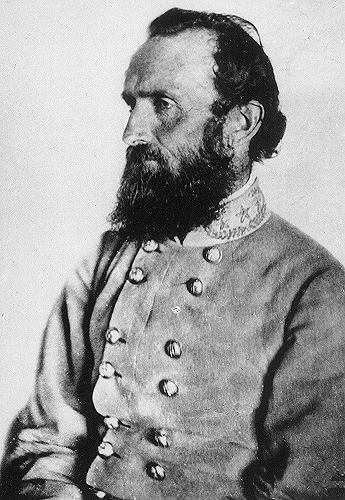
General Jackson’s “Chancellorsville” Portrait, taken at a Spotsylvania County farm on April 26, 1863, seven days before his mortal wounding at the Battle of Chancellorsville
Washington’s high society came out to watch this one, bringing their blankets, lawn chairs, and picnic baskets to cheer on the newly formed Army of the Potomac as they “taught the Secessionists a lesson.” Instead, they’d barely broken out their Mimosas before Confederates repulsed an early Union advantage, sending Federals scurrying back to Washington in the “Great Skedaddle” after hollering the infamous “Rebel Yell” at the top of their lungs. Their victory was so decisive that many Confederates just deserted, thinking the war was over. Samuel Watkins wrote of how disappointed he and his Tennessee Regiment were to arrive late on the train, having missed out:
We felt that the war was over, and we would have to return home without even seeing a Yankee soldier. Ah, how we envied those that were wounded. We thought at that time that we would have given a thousand dollars to have been in the battle, and to have had our arm shot off, so we could have returned home with an empty sleeve.
Southern ministers took victory as proof of God’s preference for the Confederacy, but First Bull Run/First Manassas might have made their soldiers overconfident. Meanwhile, Union General George McClellan used the defeat to whip the Army of the Potomac into fighting shape. If you’ll pardon consideration of some counterfactual history — generally discouraged in your author’s line of work — it’s instructive to think about what would’ve happened if the Union had won here instead or taken Richmond at any point in 1861 or ’62. Slavery wouldn’t have ended because emancipation was not yet part of the Union’s war aims.
One Confederate brigade at Bull Run led by General Thomas Jackson held up against Union troops like a “stone wall,” thus the nickname Stonewall Jackson. Jackson, along with Robert E. Lee, formed a nearly unbeatable combination in Virginia over the next couple of years that kept Union forces from taking Richmond. McClellan’s Army of the Potomac tried to sneak in the side door to Richmond from the Atlantic coast in the Peninsula Campaign, but the Confederates stymied them.
Antietam
In hindsight, Lee should’ve left well enough alone and just defended Richmond, but it’s understandable why he wanted to invade the North. Sometimes there’s no good defense like a little offense, and Lee understood from the Union example how hard invading armies can be on civilians. Home field advantage can be a disadvantage. Fresh off a Second Bull Run win and a successful invasion of Union-held Kentucky — where Confederates seated their own governor in the capital of Frankfort — Lee hoped he could demoralize Northerners, making them want to give up and, in the meantime, circle around and get into Washington from the north. Maybe he could burn Philadelphia or Baltimore while he was at it (from a northern standpoint, Baltimore already seemed like a Confederate outpost). Confederate troops could live on northern food for a while, too, helping to ration supplies back home. There were railroads and factories to capture, with supplies like shoes important for marching. Lee hoped that a northern victory, maybe capturing the key rail hub of Harrisburg, Pennsylvania’s capital, could secure a British or French alliance. But his Army of Northern Virginia’s two northern invasions failed, each featuring big losses in key battles. Antietam, in 1862, was a huge bloodletting, leading to the Emancipation Proclamation and loss of the Confederates’ potential British ally. The other, Gettysburg in 1863, nearly broke Robert E. Lee’s army, swinging momentum to the Union.
First, Lee succeeded where John Brown had failed and captured the Federal Arsenal at Harpers Ferry, Virginia. Lee, you may remember, was involved in arresting Brown there in 1859. Harpers Ferry was near the Mason-Dixon Line and changed hands eight times during the war. Confederates also made gunpowder at a secret hideout directly under a Union camp at Organ Cave, West Virginia. The Union surrendered 12.5k soldiers to Lee at Harpers Ferry in September 1862, the largest U.S. capitulation before the Battle of Bataan in the Philippines at the start of World War II. However, the Union foiled Lee’s subsequent Maryland invasion when they happened upon his battle plans, the infamous Special Orders #191, aka the “Lost Dispatch.” One of Lee’s generals wrapped his plans around three cigars in an envelope to keep the morning mist off them, but they fell out of his pocket and some Union troops chanced upon them in a clover field. McClellan naturally suspected that it was too good to be true to have these plans fall into his hands, especially since generals (including Lee) often plant misinformation, so he wasn’t sure if the letter was a ruse to draw him into a disadvantageous position. Nonetheless, McClellan suspected what Lee was up to and when and where he’d be up to it. McClellan was a good tactical general and his men respected that he didn’t throw them into harm’s way recklessly, but he was overly cautious in this case. He blocked Lee but failed to capitalize and pounce on Lee’s army when he had it outnumbered and enjoyed the element of surprise, squandering his Lost Dispatch advantage. While he frittered away the hours, mistakenly thinking his own army was outnumbered, Lee sent for reinforcements.
By the time McClellan finally engaged Lee outside Sharpsburg, Maryland near Antietam Creek, it was too late and the sides were equally matched. The Confederates staved off annihilation for hours along a four-mile front. The Battle of Antietam was the single bloodiest day in American military history, with 23k casualties (mostly injuries) in the span of a few hours — more than the American Revolution, War of 1812, and Mexican War combined. Optional Animated Map (15:31) The Union “won” insofar as they blunted Lee’s Northern invasion, but Lincoln was distraught they’d missed such a good opportunity to knock Lee out. When McClellan lamely tried to explain that he’d delayed to rest his horses, Lincoln retorted, “Why would any horses in your army be tired?” He fired the obstinate McClellan, who viewed Lincoln as a frontier hack, “an idiot,” and “the original gorilla.”
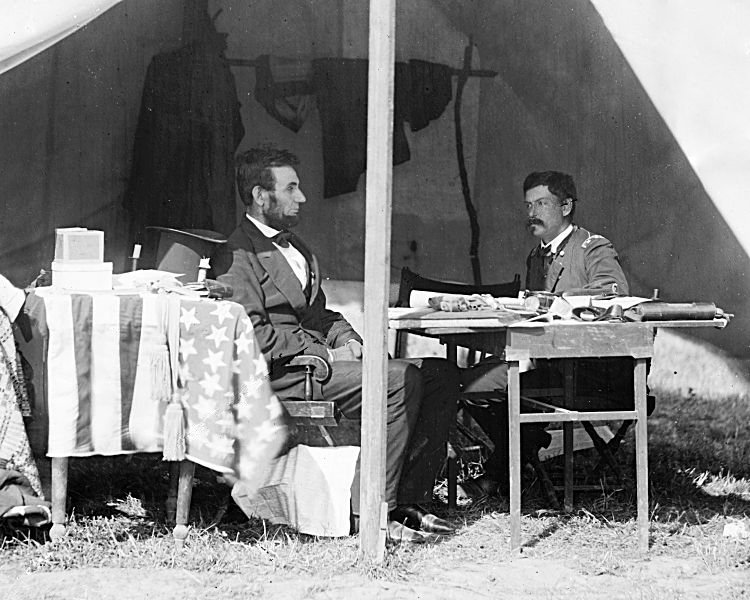
Abraham Lincoln and George B. McClellan in the General’s Tent at Antietam, October 3, 1862, Photo by Alexander Gardner, Library of Congress
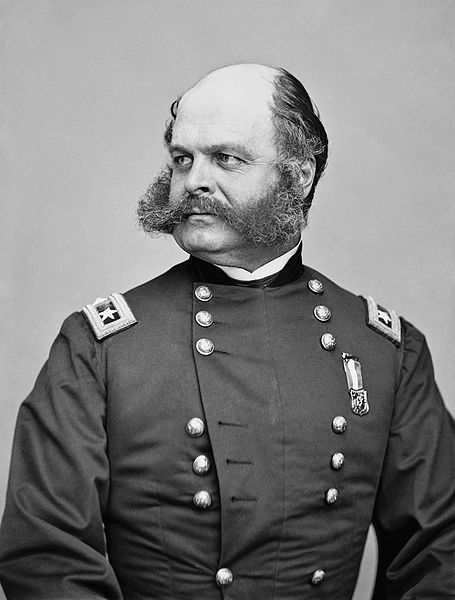
Ambrose Burnside of the Eponymous Side-Burns, ca. 1860-65, Photo by Matthew Brady, Library of Congress
Still, Lincoln couldn’t find anyone better. Ambrose Burnside, he of the famously thick mutton chops, was the opposite of McClellan, courageous but reckless, and led the Union to a resounding defeat at Fredericksburg, Virginia at the end of 1862. Joseph Hooker’s army towed around so many prostitutes that his last name became associated with the world’s oldest profession. Lee and Stonewall Jackson beat Hooker’s army at Chancellorsville, Virginia the following spring, leaving ~25k killed in the war’s deadliest battle to date — worse than Antietam. America had added two important words to its vocabulary, sideburns, and hooker, but the Union was no closer to victory. At least they’d kept the Confederates out of the North at Antietam and retained the border state of Kentucky after the Battle of Perryville a month later, stopping the CSA’s Heartland Offensive.
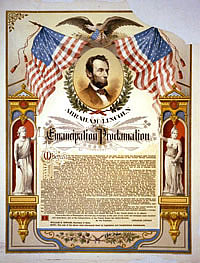 Emancipation
Emancipation
The Union gained other advantages from its army checking the Confederates at Antietam, beyond just stopping Lee’s northern invasion. For one, European countries and investors began to distance themselves from the CSA after the debacle. Moreover, the bloodletting at Antietam gave Congressional Republicans and Lincoln a cause for reframing the war as an abolitionist crusade. Lincoln could hardly explain the battle’s casualties as merely on behalf of keeping the South in the Union. He needed to frame the war in a more meaningful way and that meant the goal of abolishing slavery. Congress led the way, making their case to the skeptical Lincoln that, given the limited aim of preserving the Union, even a victory would only result in returning things to the status quo, the way they were before. The South would still have slavery and it still might spread west. All a Union victory would do under those terms is “kick the can down the road,” perhaps leading to a second war out west. By seceding, the Confederacy was technically forfeiting its claims on western territories that were part of the U.S. However, that could’ve changed had they won.
In August 1862, Lincoln famously wrote: “If I could save the Union without freeing any slave I would do it, and if I could save it by freeing all the slaves I would do it.” By October 1862, after Antietam, he had another idea for what would’ve been the Thirteenth Amendment — the near opposite of his earlier proposal to permanently legalize southern slavery. This time, he proposed an amendment to buy and deport slaves, to be completed and phased out by 1900. Real abolitionists were outraged. Frederick Douglass wrote that the president was an unprincipled racist and a bitter William Lloyd Garrison remarked that Lincoln’s upbringing among the “white trash of Kentucky” had limited his character and moral development.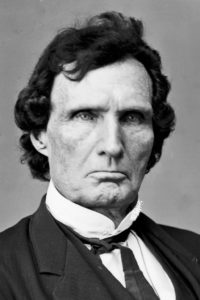
Congressional Radical Republicans like Thaddeus Stevens (right) and trailblazer John C. Fremont pushed for a more immediate solution, along with Lincoln’s VP, Hannibal Hamlin. It was time to merge military and political goals and rid the country of slavery, the institution that caused the war. People (then and now) have criticized Lincoln for waffling on slavery, but what he was really doing was staying consistent in trying to preserve the Union. Eventually, he came around to the idea that freeing enslaved workers could help the Union win by hurting the Southern economy which would, in turn, preserve the Union while eliminating the war’s primary cause. Abolition and preserving the Union fused in Lincoln’s mind, except that he would both preserve and reinvent the United States. And he remained resolute, saying “I expect to maintain this contest until successful, or until I die, or I am conquered, or the country forsakes me.” Once he changed his mind on abolition, he wasn’t going back and, as we’ll see in the next chapter, he resisted pressure to retract abolition during the 1864 presidential campaign.
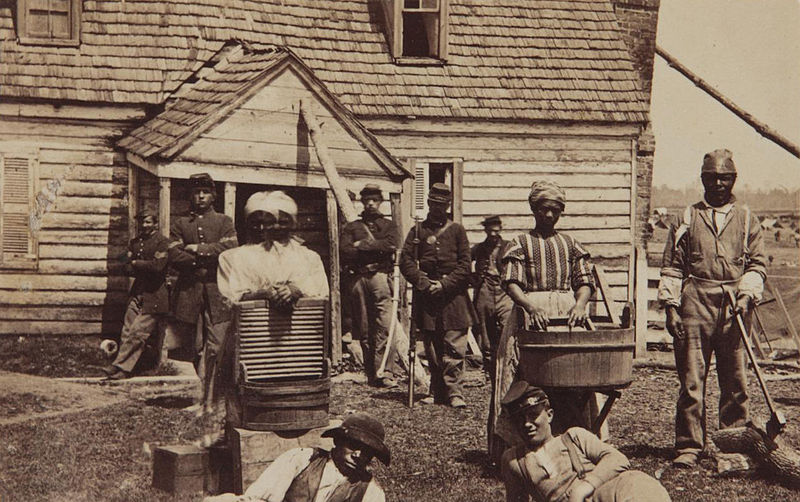
Contrabands at Headquarters of General Lafayette, Photo by Mathew Brady, Randolph Linsly Simpson African-American Collection, Beinecke Rare Book & Manuscript Library, Yale University
With the First Confiscation Act, the Union was already freeing enslaved workers during their campaigns, and they outlawed slavery in the District of Columbia, with compensation to slaveowners. The contraband camps of freed workers suffered from the same diseases as army camps, with thousands experiencing freedom for the first time only to die of typhoid or dysentery, far from home. With the Second Confiscation Act, the Union resolved to free all enslaved workers in the Confederacy, but not until Lincoln made the South one last offer to give up on independence. 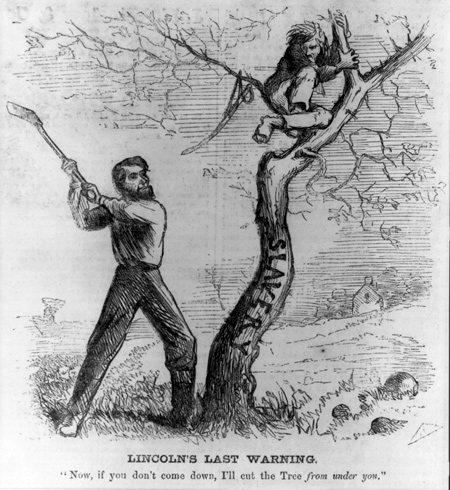
Lincoln kept his original offer of supporting southeastern slavery on the table and gave the rebellious states three months to accept those conditions if they stayed in the United States (or, from their perspective, re-joined). If they refused this offer/ultimatum, then Lincoln was raising the war’s stakes, pledging to eradicate slavery in all in the rebellious states. In the Harper’s Weekly cartoon to the left, Lincoln is giving Jefferson Davis (crouched in the tree) his final warning. This Emancipation Proclamation would result in a constructive outcome if the North won, maybe preventing another war. It was a wartime measure, though, not an inspirational moral treatise as it’s sometimes thought of. For pragmatic reasons, Lincoln preserved slavery for the time being in Missouri, Kentucky, Maryland, and Delaware, the four slave states remaining in the Union — an offset to his suspension of habeas corpus. Keeping order in those “loyal” states was hard enough without alienating their planters even more. He also exempted from abolition contested Tennessee and other Union-held Confederate areas like eastern Virginia and the parishes of southeastern Louisiana in order to placate white Southerners who might defect from the Confederacy and/or eventually reintegrate into the Union. Moreover, few slaves were freed in the South since they didn’t answer to U.S. rule. Almost no one was freed on January 1st, 1863, the day the three-month offer expired and emancipation kicked in. The pro-Confederate London Times called the Emancipation Proclamation a “Papal bull against a comet,” likening it to a Catholic Pope trying to affect space phenomena. Still, the Union Army would continue to free enslaved Deep Southerners and Maryland voted to abolish on its own in 1864. Harriet Tubman (Chapter 15) helped out in the 1863 Raid on Combahee Ferry in South Carolina, that freed 750 enslaved people, many of whom joined the Union Army. Most importantly, everyone in captivity would be freed if the Union won the war, a promise Congress helped secure by passing the Thirteenth Amendment in 1865. By coincidence, America’s future rival Russia freed its serfs around the same time, in 1861. Serfs had varying status, with some more similar to sharecroppers than enslaved workers, and they were bought and sold along with the land they worked.
The Emancipation Proclamation also called for freed Blacks to “labor faithfully for reasonable wages,” marking Lincoln’s abandonment of colonization, in his case the idea of sending freed slaves to Panama rather than Africa. Freedman, as they came to be called, would remain and work in the U.S. in a biracial society. Another underrated feature of the Proclamation was that it called on Blacks to fight. They’d already served in various military capacities, but now they’d be in combat. African Americans took part in their own emancipation as Frederick Douglass, now in the president’s camp, goaded Lincoln into a controversial decision to form black units in the Union army. Confederates issued a proclamation of their own that any black POW or white officer leading black troops would be executed on site if captured in battle, rather than taken prisoner. However, that backfired because it made black soldiers fight even harder and deprived the CSA of prisoners to swap for their own.
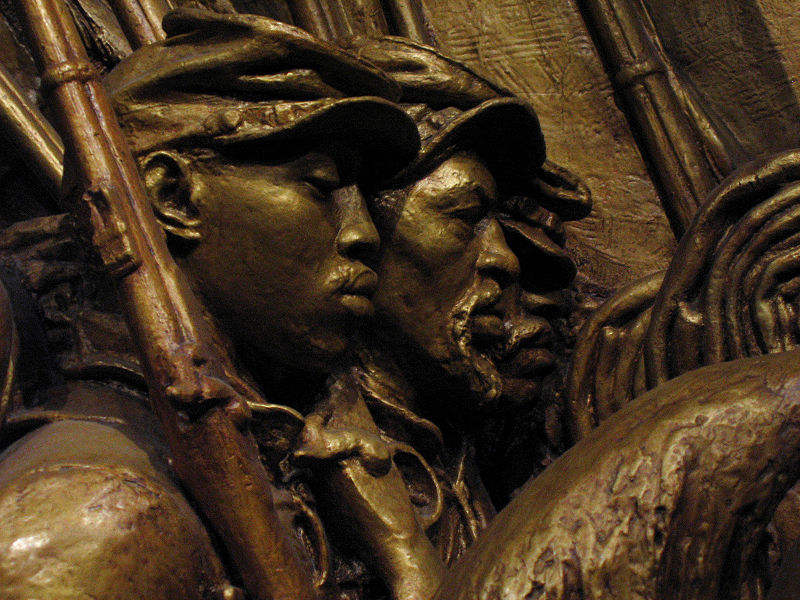
Detail from Memorial to Robert Gould Shaw and the Massachusetts Fifty-Fourth Regiment, Augustus Saint-Gaudens, National Gallery of Art, Washington
Hollywood gets a lot of flak for inaccuracies in historical movies, but they did the opening chapter of this story justice with Glory (1989). They based the script loosely on the letters of Robert Gould Shaw, the white colonel and son of Boston abolitionists who commanded the Massachusetts 54th Infantry Regiment. The volunteer regiment fought against racist leaders and quartermasters in the Union Army who didn’t want them to actually fight and kept them under-supplied. But Shaw lobbied for them to take on a more meaningful role than manual labor or pillaging expeditions and the movie concludes with the 54th’s heroic but failed attempt to storm Fort Wagner (2nd Assault on Morris Island) on the South Carolina coast, near Charleston. Ultimately, 180k black troops fought in the war and over 40k enslaved and free Blacks gave their lives for the cause. By comparison, around 1/35 Americans serving in WWII died. A new 1st Louisiana Native Guards (73rd Regiment of Union Colored Troops) formed, this one fighting for the Union at key spots like Fort Hudson.
Abolishing slavery and enlisting black soldiers were huge gambles for Lincoln. Blacks and abolitionists would support the war more than before, but northern racists might abandon the cause. George McClellan angrily warned that the entire Army of the Potomac would quit en masse if they learned they were now fighting for Blacks, but the “idiotic frontier hack” and “gorilla” Lincoln wisely called his bluff.
Lincoln’s Struggles
Emancipation came at a time when Lincoln was struggling to lead the Union. Some in his administration were most concerned with lining their own pocketbooks through contract kickbacks. The Union government was a huge customer for uniforms, guns, horses, beef, etc. Fortunes were made winning these contracts and small portions could be “kicked back” (returned) to the politicians responsible for awarding them. Amidst these graft scandals, the public and press subjected the president to withering criticism as the war went poorly for the Union in the first two years.
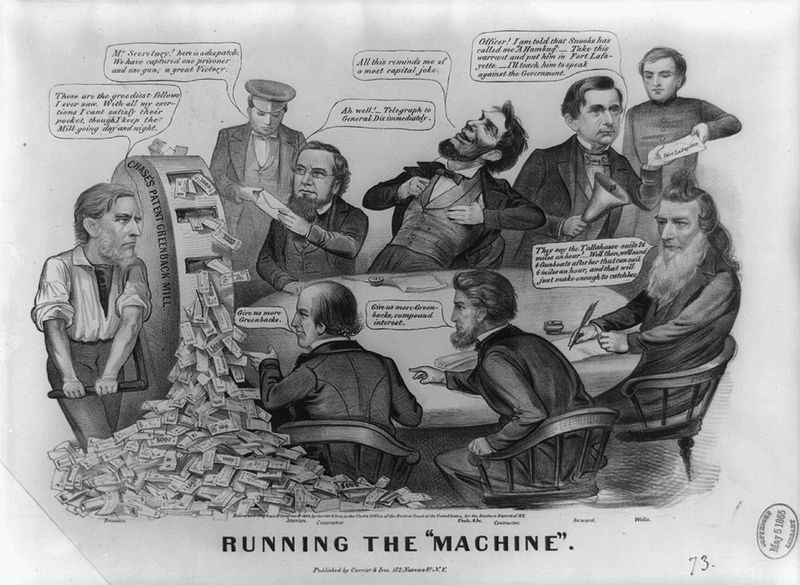
This cartoon derives its title from an indiscreet letter written by Secretary of War Edwin Stanton to past President James Buchanan immediately following the Union army’s defeat at the Battle of Bull Run. Stanton wrote, “The imbecility of this Administration, culminated in that catastrophe (Bull Run), and irretrievable misfortune and national disgrace never to be forgotten are to be added to the ruin of all peaceful pursuits and national bankruptcy, as the result of Mr. Lincoln’s `running the machine’ for five months.” Artist John Cameron, Library of Congress
Lincoln struggled personally with depression, a difficult marriage with Mary Todd, and his third son Willie (right, center) dying of typhoid at age eleven. According to historian Joshua Shenk, even before Willie’s death, Lincoln had been seen reading in the Old Testament about Abraham’s willingness to sacrifice his son Isaac to God to prove his faith. Lincoln identified with the story because of how many soldiers he was sacrificing to save the Union and the loss of his own son magnified the sorrow. Mary Todd conducted séances in the White House to reach Willie and one story spread that Abe pulled his son’s corpse out of its crypt to carry it around in the middle of the night. Mary Todd became addicted to Laudanum, an opium tincture. Two close friends that moved with Lincoln from Illinois to Washington had died in the war. Meanwhile, he met dutifully with lines of grieving parents that encircled the White House daily. Death had never been far from Lincoln. His mother died when he was nine, Native Americans killed his brother, and his sister died when he was 20, as did the girl he hoped to marry. Now, with ongoing threats of his own assassination, he was doing all he could to keep from going unhinged. Lincoln relied mainly on the Bible and Shakespeare’s plays for inspiration while spending many nights sleeping in the telegraph room awaiting word from the battlefield.
The telegraph brought the Commander-in-chief close to the battlefield for the first time in American history, and Lincoln’s generals found his interference irritating. He, in turn, was impatient with their conservative tactics. Lincoln wanted aggression, especially aimed at destroying Richmond, not just victories between armies on the battlefield. His generals, though, were most concerned with just opposing Confederate armies and fought cautiously, never severing their own supply lines.
 Not Quite A Nation
Not Quite A Nation
The Union’s problems didn’t translate into southern success. They, too, had problems. The CSA was a reasonably large and wealthy country by global standards, but it was smaller than the Union in terms of population (3.5x more), industrial output, and agricultural production. The Confederacy was the 4th-largest economy in the world, but its power was predicated on being able to export cotton. The Union blockade, or “Anaconda,” slowed exports down considerably, maybe 20-fold. The South had decent railroads but the CSA never took control of them and private companies didn’t coordinate well with militias. When they did transport troops, it took cars away from food transport. There weren’t enough railroads to both feed everyone and move troops around. There were supply shortages stemming partly from that, but also from planters being unwilling to turn their cotton fields over to grow food, holding out hope instead to export cotton abroad. That caused food shortages and bread riots, often led by women. Some rioters even threatened the Confederate White House in Richmond. 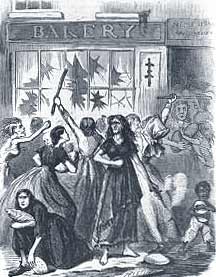
Like all young governments, including the U.S. after its Revolution, the Confederacy struggled to establish currency. Even gold-backed currency is only worth the paper it’s printed on unless a critical mass trusts that the government issuing it will still be around years later to redeem it. When the value drops, the natural tendency is to print more of it, but that only spurs inflation. Meanwhile, the North succeeded in raising funds, selling war bonds through a network of banks and printing cash. Philadelphia banker Jay Cooke organized the bond sales. Alexander Hamilton would’ve been proud had he still been around.
American cash, as we know it today, is a product of the Civil War. Paper money and notes existed all the way back to the Revolution, but they were often issued by private banks or states. Counterfeiting was rampant (today less than 1% of cash is counterfeit). Locally-issued paper notes were increasingly worthless the further one traveled from that bank, as was shinplaster, a sort of 19th-century version of redeemable coupons issued by merchants and transportation companies and traded as de facto currency. During the Civil War, the Union government took over and created a monopoly in Union Greenbacks, then created the Secret Service to police counterfeiting.
As in the North, the South ran out of volunteer soldiers the first year. Like the Union draft, the CSA exempted the rich — in this case, the very planter class on whose behalf the war was arguably being fought. The Twenty Negro Law exempted one person per plantation per 20 slaves owned. They reduced the number to 15 when they discovered that too many planters had sons in combat. Desertion rates skyrocketed, reaching as high as 40% by the end of the war. One famous and early Confederate deserter was Mark Twain, whose Adventures of Huckleberry Finn (1884) was an indirect broadside against slavery, though it was later censored because of its use of the n-word. Though many poor Whites had one or two enslaved workers themselves and others made money policing plantations, resentment toward the Confederacy formed along class lines. The South also trailed the North on accepting Pasteur’s germ theory and most medics weren’t washing their hands before surgery or cleaning out wounds.
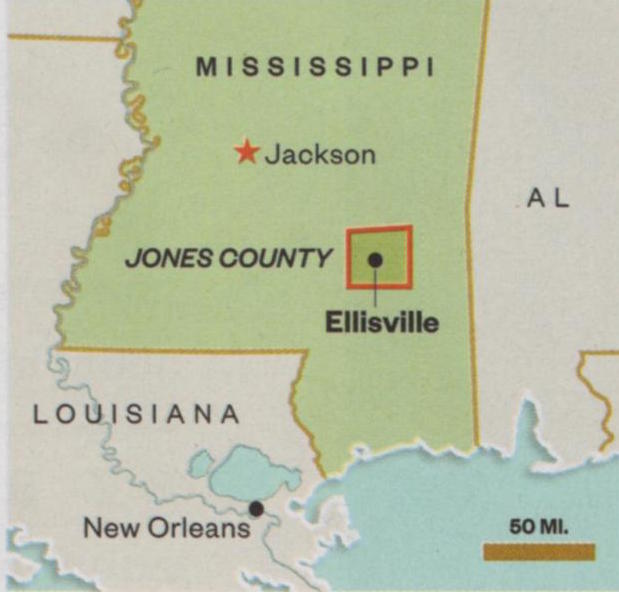 Finally, there was the issue of states’ rights. For true adherents to local government, there was no reason for southern states or even counties to work in tandem with the Confederacy. Jefferson Davis’ mediocre leadership exacerbated states’ tendency to defy centralized authority. Fistfights broke out on the floors of the Confederate Congress and many state militias fought virtually on their own, without taking orders from CSA leaders. Some areas of the South even seceded from the Confederacy, like the Kingdom of Jones in Mississippi led by Republican Newton Knight, featured in Matthew McConaughey’s Free State of Jones (2016). Knight and his men deserted from the 7th Battalion of Mississippi Infantry. Angry at the Twenty Negro Law, his guerrilla troops raised the U.S. flag over the Jones County courthouse and Knight later courageously raised a mixed-race family in the Ku Klux Klan hotbed. Future Neo-Confederates have marginalized Knight as a mere outlaw because his story disrupts their mythology of a unified South, but Jones County was not alone. Whole regions without enslaved people broke away from their young country. Whether opposing the war effort or supporting it, many regions didn’t want to be told what to do by a centralized CSA. An exasperated Jeff Davis said, “If the Confederacy is to die, let it be written on its tombstone that it died of an ideology: states’ rights.” His frustrations as a leader probably made him more likely to attribute secession itself to states’ rights after the war.
Finally, there was the issue of states’ rights. For true adherents to local government, there was no reason for southern states or even counties to work in tandem with the Confederacy. Jefferson Davis’ mediocre leadership exacerbated states’ tendency to defy centralized authority. Fistfights broke out on the floors of the Confederate Congress and many state militias fought virtually on their own, without taking orders from CSA leaders. Some areas of the South even seceded from the Confederacy, like the Kingdom of Jones in Mississippi led by Republican Newton Knight, featured in Matthew McConaughey’s Free State of Jones (2016). Knight and his men deserted from the 7th Battalion of Mississippi Infantry. Angry at the Twenty Negro Law, his guerrilla troops raised the U.S. flag over the Jones County courthouse and Knight later courageously raised a mixed-race family in the Ku Klux Klan hotbed. Future Neo-Confederates have marginalized Knight as a mere outlaw because his story disrupts their mythology of a unified South, but Jones County was not alone. Whole regions without enslaved people broke away from their young country. Whether opposing the war effort or supporting it, many regions didn’t want to be told what to do by a centralized CSA. An exasperated Jeff Davis said, “If the Confederacy is to die, let it be written on its tombstone that it died of an ideology: states’ rights.” His frustrations as a leader probably made him more likely to attribute secession itself to states’ rights after the war.
Diplomacy
Confederate diplomacy didn’t go as planned, either. Historian Christopher Dickey wrote that the history of wars is largely “the history of delusions, those dreams of rapid victory based on simple strategies that lead to long nightmares of slaughter.” One Southern delusion was their assumption that Britain’s dependence on cotton would surely bring them in on the Confederate side of the conflict. Britain was the most important market after the U.S., with the South supplying 80% of the cotton feeding its textile mills. And things got off to a rocky start between Britain and the Union when the U.S. Navy apprehended two Confederate diplomats aboard a British ship (the Trent Affair), whom they later released to avoid escalating a diplomatic conflict. Britain and France also feared the northern United States as potential global rivals for colonial territories, so had cause to weaken them. However, Britain didn’t want to back a potential loser in the CSA and it didn’t help that Britain had abolished slavery in 1833 (and France a second time in 1848 after their 1789 emancipation didn’t survive Napoleon). Pro-Confederacy Brits contended with abolitionist “Uncle Tomism.” Lincoln sent evangelical Henry Ward Beecher to Europe to speak on behalf of the Union and he proved effective. Later, at the end of the war, Lincoln sent Beecher to Fort Sumter to give a speech and raise the Stars-and-Stripes. As a coda to Lincoln’s earlier hyperbole about his sister, Harriet Beecher Stowe, being the “little woman who wrote this great book (Uncle Tom’s Cabin) that started this big war,” Lincoln said that he better send her brother to Sumter for the flag-raising because “if it had not been for Beecher, there would be no flag to raise.”
British statesman John Bright would’ve been a natural candidate to back the Confederacy as the son of a cotton mill owner; but, as a Quaker, he opposed slavery. He was president of England’s Board of Trade. Lincoln had just two portraits in his office, Bright and Andrew Jackson, the president who’d famously put down South Carolina’s nullification revolt (Chapter 13). When he was shot in 1865, Lincoln had a newspaper article by Bright in his pocket. Confederates hoped the British needed their cotton enough to seal an alliance, but they were hesitant to go too far out on a limb if there was a good chance the U.S. would win, as it appeared they might after Antietam. Still, Britain opposed the Union’s preference for tariffs and it built some ships in Liverpool to help the Confederacy break through the blockade, most notably the CSS Alabama that wreaked havoc on the U.S. Navy. The Brits also smuggled in Whitworth rifles popular among Confederate soldiers. At the Battle of Spotsylvania Courthouse in 1864, Union General John Sedgwick chided his troops for taking cover with Grays 800-1000 yards away. His last words were “they couldn’t hit an elephant at this distance” before a Whitworth hexagonal .451 caliber bullet fatally cracked his skull.
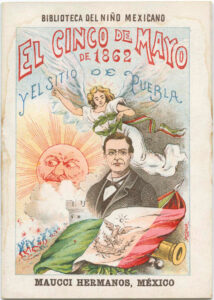 The rest of Europe was also divided. Russia was the only unequivocally pro-Union government and even set about confiscating Confederate ironclad warships. Britain valued an alliance with the emerging new country of Italy and their popular leader Giuseppe Garibaldi was a vocal abolitionist who wondered aloud, “So is this war about ending slavery or what?” He sent letters to British officials urging support for Lincoln and the Union. Queen Victoria of Great Britain also sent a letter encouraging emancipation. Elsewhere in Italy, Pope Pius IX regretted the “intestinal war,” urging Irish Americans and other Catholics to “not fight for zealous Puritans [the Union].” French Emperor Napoleon III advocated joint French-British recognition of the CSA, but it never materialized. Napoleon III’s real goal was to use the American Civil War as a cover for conquering Mexico, and a Confederate victory would’ve created a buffer between French Mexico and the Anglo-American North. Cinco de Mayo doesn’t celebrate Mexican independence from Spain in 1821, but rather Mexico’s victory over France at the 1862 Battle of Puebla.
The rest of Europe was also divided. Russia was the only unequivocally pro-Union government and even set about confiscating Confederate ironclad warships. Britain valued an alliance with the emerging new country of Italy and their popular leader Giuseppe Garibaldi was a vocal abolitionist who wondered aloud, “So is this war about ending slavery or what?” He sent letters to British officials urging support for Lincoln and the Union. Queen Victoria of Great Britain also sent a letter encouraging emancipation. Elsewhere in Italy, Pope Pius IX regretted the “intestinal war,” urging Irish Americans and other Catholics to “not fight for zealous Puritans [the Union].” French Emperor Napoleon III advocated joint French-British recognition of the CSA, but it never materialized. Napoleon III’s real goal was to use the American Civil War as a cover for conquering Mexico, and a Confederate victory would’ve created a buffer between French Mexico and the Anglo-American North. Cinco de Mayo doesn’t celebrate Mexican independence from Spain in 1821, but rather Mexico’s victory over France at the 1862 Battle of Puebla.
The Confederacy sold war bonds in Amsterdam redeemable in cotton futures to finance their war effort, but the price didn’t rise much as Egypt and India picked up the production slack caused by the Union blockade. There was enough cotton in the pipeline for British textile mill owners to get by for a few years without the South. When prices finally rose enough to hurt smaller textile mills, bigger mills lobbied Parliament to do nothing so that their smaller rivals would be driven out of business. The bigger mills could ride out the storm until the war was over when even more cotton flowed than before.
Finally, Confederate espionage wasn’t enough to offset similar subterfuge on the Union’s part, and they never broke the Union’s telegraph code. One Confederate plot involved biological warfare in the form of smallpox-infested clothing sent to northern charities. However, the virus didn’t live long enough to infect anyone. Numerous assassination plots against Lincoln failed until Booth’s famous attempt late in the war.
Stalemate
We mentioned earlier how both sides usually think they’ll win quickly at the beginning of wars. So too, both sides often have the sensation of losing once the war has been going for a while. The Union was tired of losing so many battles and troops and the southern economy was hanging by a thread. Citizens on neither side agreed on what they were fighting for. Soldiering was hard, boring, and dangerous, with endless hours of marching, sitting around, and sleeping on cold or mosquito-infested ground punctuated by brief bursts of life-threatening terror and pain. Syphilis was rampant among soldiers and camp followers that included some wives but mainly prostitutes.
Worse, the chances of surviving capture declined as the war progressed. The prisoner exchange program broke down in 1863. By then, the North calculated that they could afford to lose soldiers more than the South, so they stopped exchanging prisoners. And as we saw above, when the North started using black troops, the South refused to take them as POWs, re-enslaving or massacring captives instead, most notoriously at Fort Pillow, Tennessee (above). Jefferson Davis insisted that, since freeing slaves violated the rules of war, they would treat black POWs as criminals and potential contraband rather than combatants. Lincoln countered in his Lieber Codes that discriminating against POW’s based on race violated the rules of war. Confederates rejected the demands of Lincoln’s General Order 252 that promised, for each black Union POW killed or enslaved, an eye-for-an-eye execution and/or hard labor for one Confederate POW. The two sides were talking past each other and the exchange program came to a halt.
Torture, mistreatment, and medical experimentation occurred in both Union and Confederate camps. Being sent to Camp Douglas in Chicago, Rock Island, Illinois, Governors Island in New York Harbor, or Johnson’s Island (Lake Erie) was usually a death sentence for Confederates, often from freezing. Union troops’ treatment in Andersonville, South Carolina was no better, where most of the prisoners died of disease or starvation. By 1863, it was plain that soldiers on both sides and southern civilians were in for a long haul.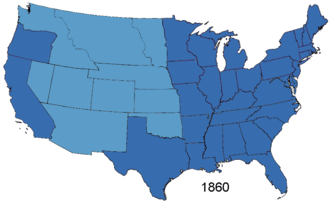 Optional Reading & Viewing:
Optional Reading & Viewing:
Battlefield Animated Maps (Civil War Trust)
Civil War: 150 Years (National Park Service)
George Forgie, “Work Left Undone: Emancipation Was Not Abolition” Not Even Past
Lincoln’s Letter of Condolence to Fanny McCullough (12.23.1862)
Civil War History & Stories (Learn Civil War History, Jonathan R. Allen)
Writings on the Civil War (Karl Marx & Frederick Engels, 1861)
Podcast (36 Min.): Lincoln’s Evolving Thoughts On Slavery (NPR Fresh Air, 10.11.10)
Tera Hunter, “When Slaveowners Got Reparations,” (NYT 4.16.19)
